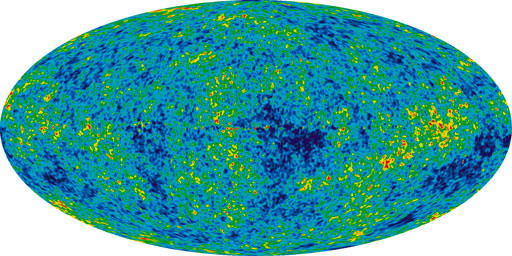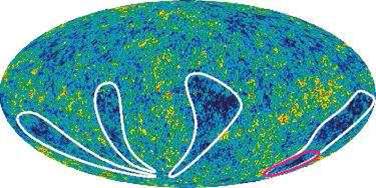Since the day the first Wilkinson Microwave Anisotropy Probe (WMAP) data were released, in 2003, all manner of cosmic microwave background (CMB) anomalies have been reported; there’s been the cold spot that might be a window into a parallel universe, the “Axis of Evil”, pawprints of local interstellar neutral hydrogen, and much, much more.
But do the WMAP data really, truly, absolutely contain evidence of anomalies, things that just do not fit within the six-parameters-and-a-model the WMAP team recently reported?
In a word, no.

Every second year since 2003 the WMAP science team has published a set of papers on their analyses of the cumulative data, and their findings (with the mission due to end later this year, their next set will, sadly, be their last). With time and experience – not to mention inputs from the thousands of other researchers who have picked over the data – the team has not only amassed a lot more data, but has also come to understand how WMAP operates far better. As a consequence, not only are the published results – such as limits on the nature of dark energy, and the number of different kinds of neutrinos – more stringent and robust, but the team has also become very au fait with the various anomalies reported.
For the first time, the team has examined these anomalies, in detail, and has concluded that the answer to the question, in their words, “are there potential deviations from ?CDM within the context of the allowed parameter ranges of the existing WMAP observations?” is “no”.
The reported anomalies the team examined are many – two prominent cold spots, strength of the quadrupole, lack of large angular scale CMB power, alignment of the quadrupole and octupole components, hemispherical or dipole power asymmetry, to name but a handful – but the reasons for the apparent anomalies are few.
“Human eyes and brains are excellent at detecting visual patterns, but poor at assessing probabilities. Features seen in the WMAP maps, such as the large Cold Spot I near the Galactic center region, can stand out as unusual. However, the likelihood of such features can not be discerned by visual inspection of our particular realization of the universe,” they write, and “Monte Carlo simulations are an invaluable way to determine the expected deviations within the ?CDM model. Claims of anomalies without Monte Carlo simulations are necessarily weak claims”.

An amusing example: Stephen Hawking’s initials (“SH”) can be clearly seen in the WMAP sky map. “The “S” and “H” are in roughly the same font size and style, and both letters are aligned neatly along a line of fixed Galactic latitude,” the team says; “A calculation would show that the probability of this particular occurrence is vanishingly small. Yet, there is no case to made for a non-standard cosmology despite this extraordinarily low probability event,” they dryly note.
Many of the reports of WMAP CMB anomalies would likely make for good teaching material, as they illustrate well the many traps that you can so easily fall into when doing after-the-fact (a posteriori) statistical analyses. Or, as the team puts it in regard to the Stephen Hawking initials: “It is clear that the combined selection of looking for initials, these particular initials, and their alignment and location are all a posteriori choices. For a rich data set, as is the case with WMAP, there are a lot of data and a lot of ways of analyzing the data.”
And what happens when you have a lot of data? Low probability events are guaranteed to occur! “For example, it is not unexpected to find a 2? feature when analyzing a rich data set in a number of different ways. However, to assess whether a particular 2? feature is interesting, one is often tempted to narrow in on it to isolate its behavior. That process involves a posteriori choices that amplify the apparent significance of the feature.”
So, does the team conclude that all this anomaly hunting is a waste of effort? Absolutely not! I’ll quote from the team’s own conclusion: “The search for oddities in the data is essential for testing the model. The success of the model makes these searches even more important. A detection of any highly significant a posteriori feature could become a serious challenge for the model. The less significant features discussed in this paper provided the motivation for considering alternative models and developing new analysis of WMAP (and soon Planck) data. The oddities have triggered proposed new observations that can further test the models. It is often difficult to assess the statistical claims. It may well be that an oddity could be found that motivates a new theory, which then could be tested as a hypothesis against ?CDM. The data support these comparisons. Of course, other cosmological measurements must also play a role in testing new hypotheses. No CMB anomaly reported to date has caused the scientific community to adopt a new standard model of cosmology, but claimed anomalies have been used to provoke thought and to search for improved theories.”
Primary source: Seven-Year Wilkinson Microwave Anisotropy Probe (WMAP) Observations: Are There Cosmic Microwave Background Anomalies? (arXiv:1001.4758). The five other Seven-Year WMAP papers are: Seven-Year Wilkinson Microwave Anisotropy Probe (WMAP) Observations: Cosmological Interpretation (arXiv:1001.4538), Seven-Year Wilkinson Microwave Anisotropy Probe (WMAP) Observations: Planets and Celestial Calibration Sources (arXiv:1001.4731), Seven-Year Wilkinson Microwave Anisotropy Probe (WMAP) Observations: Sky Maps, Systematic Errors, and Basic Results (arXiv:1001.4744), Seven-Year Wilkinson Microwave Anisotropy Probe (WMAP) Observations: Power Spectra and WMAP-Derived Parameters (arXiv:1001.4635), and Seven-Year Wilkinson Microwave Anisotropy Probe (WMAP) Observations: Galactic Foreground Emission (arXiv:1001.4555). Also check out the official WMAP website.


The telescope is clearly upside down. SH, when looked at with your head down (try it!) spells HS, clearly Homer Simpson. Doh!
I presume there was minimal kurtosis in these distributions. This is good to know, for cosmology makes sense this way. These anisotropies are largely due to a quantum fluctuation, such as the scalar field of inflation (inflaton), and we would not expect statistics which violated this, such as significant non-Gaussian distributions.
LC
Also you can note teams that made it their carrier to criticize WMAP statistics on the arxiv feeds. They hammer the same claim for 7 years. (But why does it feel like 10? :-o)
I expect the Planck probe will get the same treatment. But as the WMAP team wisely notes, it’s actually good for the science as long as it is valid and testable claims, regardless of the nutty motivations behind.
If you red-shift infrared you get microwaves. What scientific evidence is there to disprove CMB isn’t just red shifted IR or possibly light from even further distances than our current big bang & inflation theory allows?
SteveZodiac, do you have a cosmological theory that suggests the CMB is from further away? Do you even understand what it is caused by, for that matter? Understand what you ‘criticise’ first before asking such questions or you’ll just sound like a fool.
We do have that the CMB is “just” red shifted IR radiation. The question is what is doing the red shifting? Locally we know that galaxies move outwards at a velocity v = Hd, for d their distance away and H = 74km/s/Mpc the Hubble constant. For close distances d is determined by luminosity-periodicity relationship on Cepheid variables, v is determined by optical red shifting and the H is then determined.. So this red shifting is by various arguments and data to support them due to the expansion of the universe, and further this expansion is due to the expansion of space itself by the frame dragged or co-moving of points away from each other. It is a general relativistic process.
Now think of a cubic volume of space. For every photon which enters it on average another one exits. So we may then model the volume as an electromagnetic or optical cavity with standing electromagnetic waves in it. Now since the universe is expanding by a relativistic geometrodynamical process of sliding points apart this cubic volume is also expanding. As a result the standing waves of electromagnetic field are also being stretched out, which is how there is cosmological red shifting of electromagnetic radiation.
LC
Now think of a cubic volume of space. For every photon which enters it on average another one exits. So we may then model the volume as an electromagnetic or optical cavity with standing electromagnetic waves in it.
What?
A photon moves in… another moves out. Yet, there is some cavity with standing waves in it?
…the universe is expanding by a relativistic geometrodynamical process of sliding points…
…huh? Or maybe a hardy laugh
Can you simplify whatever you are saying into normal words?
Stephen Hawking??? My friends, it stands for the great Sam Houston. Stephen Hawking, indeed. Is he a Texan? I think not.
@Aodhhan: Considering a volume of space with standing wave photons is a canonical way many cosmologists think about this, or communicate the theory of cosmological redshift. It is not unique to me. In the de Sitter or FLRW metric the universe is indeed a dynamical system where points of space are sliding apart.
LC
Explain it to me please… I don’t understand what you are saying.
If you have a photon of a certain wavelength enter the box, then on average one also leaves. It is a continuity condition. So the box is similar to an EM cavity. Now consider photons with a wavelength some half integer fraction of the dimensions of the box. Thus the box is approximately a resonance cavity. The expansion of space is then eqivalent to expanding the sides of the resonance cavity, which expands the wavelength of radiation inside.
LC
If Steve Zodiac was asking that question from the point of view of someone who wasn’t an expert but merely somebody who was interested in the subject then it was perfectly valid. Far from sounding like a fool he sounded like someone who wanted to know answers. Not everyone here is as well versed in cosmology/multi-dimensional physics as some and it’s a difficult concept to get your head around.